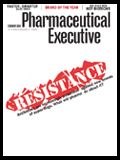Big Deals
Many say licensing is the new R&D. We've rounded up the unions to watch from the third quarter of 2007.
There's no question that Big Pharma has made the acquisition of smaller pharma companies and biotechs a significant part of its strategy for developing new products. At press time, the deal flow for the preceding month included the announcement of Roche's definitive agreement to acquire the diagnostics firm Ventana Medical Systems for $3.4 billion, Glaxo's $1.65 billion acquisition of Reliant, and Teva's $400 million agreement to acquire CoGenesys, a privately held biotech that was formerly a division of Human Genome Sciences.

At A Glance
But for all the focus on M&A, there are also some interesting developments in the world of licensing. Deal size, especially up-front cash, is up. "Unambiguously there is a movement toward larger upfronts, particularly if you look at Phase I and II," says Ben Bonifant, leader of Campbell Alliance's business development practice. "It's very likely a matter of supply and demand. There's no mystery about which compounds are the more exciting ones."
There's also a return to the idea that a deal should be structured in a way that keeps the biotech committed to and working on the project, Bonifant says. Indeed, in some of the most ambitious new license deals, there's a tendency to license a platform technology instead of or in addition to a product—mirroring a distinct trend in the M&A space.
What follows is a look at some of the hottest licensing deals of Q3 2007.
This deal between the British drug giant and the tiny California biotech is very much of the moment: a new pathway in the hot field of oncology and a cool $1.4 billion in milestone payments. What's as old as the industry itself, though, is the high likelihood that neither drug nor milestones will ever materialize.
"We're talking about biotech dollars, not exactly real money, at least just yet," says Graig Suvannavejh, a biotech analyst at UBS. "GSK is putting a bet down on a very novel—and while exciting, a largely unproven—approach. And while I could be wrong, I would be surprised if they end up paying out more than $50 million."

Marcel Wijma, SNS Securities
The alliance was struck last December by GSK's Centre of Excellence for External Drug Discovery (CEED), a seven-member team that trawls the biopharma sea for innovative R&D and then cooks up partnerships for out-of-house drug development. The early financing was not disclosed, but OncoMed CEO Paul Hastings called it "a substantial amount of money to help push the company forward." OncoMed, which was founded in 2004, will grow from its current staff of 62 to "no more than 75 by the end of the year," Hastings added.
Despite the odds of success, the deal has several noteworthy features. Analysts were quick to point out that the potential overall price tag was the highest ever for a company that hadn't yet made it into the clinic. "There was speculation that Big Pharma would not do large deals for preclinical candidates," said Alan Mendelson, a partner at Latham and Watkins, which brokered the deal for OncoMed. "[This] is evidence that, for the right technology, with the prospect of multiple product opportunities, the far-sighted pharmaceutical companies [will]."
GSK's signature "cherry-picking" strategy toward licensing, and its use of milestone payments, expose the firm to as little risk as possible while incentivizing OncoMed to move fast. The biotech plans to file an investigational new drug application for its lead product, OMP-21M18, and start Phase I trials this year. Even in a best-case scenario, the cancer therapy isn't likely to make it to market for another eight to 10 years, according to Suvannavejh.
The impressive milestone money reflects the promise of OncoMed's platform. The biotech is developing humanized monoclonal antibodies targeted to kill cancer stem cells in solid tumors. Many researchers believe that these are not only the most malignant cells—and most resistant to treatment—but the ones that actually drive tumor growth. A drug able to take out cancer stem cells could prevent the return of the tumor following first-line therapy. Odds are good that it would also work against a host of different cancers, including breast, colon, prostate, and lung. And since most solid tumors do recur, it's no exaggeration to say that such a drug would revolutionize cancer treatment.

At A Glance
"There's no question that stem cells are very sexy right now," Suvannavejh says. "They're kind of a futuristic concept, but we still haven't seen much success in clinical development." On the other hand, he adds, "humanized monoclonal antibodies are a good class of compounds, especially for oncology."
If OncoMed achieves proof of concept (Phase IIa), clinical development and commercialization will pass to GSK. The biotech has the option of upping its royalties on sales by helping to bankroll Phase III.
"It's a shot on goal by GSK," Suvannavejh says. "Every drug giant needs to make many, many shots on goal every year to keep coming up with winners tomorrow—and in 10 years." –WALTER ARMSTRONG
The mother of all partnering discovery deals." That's the way Simon Moroney, cofounder and CEO of MorphoSys, characterizes the deal recently struck between his company and Novartis.
The Swiss pharma giant has agreed to pay the German biotech $600 million of committed cash to flow over the next 10 years (with 50 percent in research support and 50 percent in the form of technology access fees).
MorphoSys will receive another $400 million in milestone payments—an estimate based on what the company realistically thinks is the likely flow of products through development.
The deal, Moroney says, leaves MorphoSys with enough independence, security, and financial strength to expand its own drug-development activities. "And, of course, we have the freedom to take those programs that we have originated to other partners," Moroney said in an interview with pharmatelevision.com.
And there's plenty for Novartis in the deal too, according to Marcel Wijma, senior equity analyst at SNS Securities, a Dutch investment bank.
"Under the agreement, Novartis makes a long-term commitment to MorphoSys' HuCAL technology, which consists of a database of more than 12 billion fully human antibodies," says Wijma. "With this technology, MorphoSys is able to design fully human antibodies against several types of diseases via phage display."
Novartis and MorphoSys began their collaboration in May 2004. To date, according to the companies, it has yielded multiple active therapeutic antibody programs across various diseases, and the first IND-filings came three years after initiation.

Yaghi Maher, Desjardins Securities.
Biologics make up 25 percent of the preclinical pipeline at Novartis and are increasingly a priority in its R&D activities.
"This is not the first deal Novartis has made with a biotech company with a technology platform," says Wijma. "Already in an early [preclinical] stage, Novartis gets the option on a large portion of the pipeline of antibodies of MorphoSys. Novartis signed the same type of deal with Austrian vaccine company Intercell. Worth several hundreds of millions, the deal gave Novartis exclusive access to Intercell's technology platform in the development of vaccines against infectious and bacterial diseases."
Equity was not a component in the current agreement with MorphoSys, partly because Novartis is already MorphoSys' most important shareholder, with a stake of 6.8 percent.
"Interestingly enough, the second major shareholder is AstraZeneca," says Wijma. "AstraZeneca bought CAT in 2006. CAT was one of the most important competitors of MorphoSys and has comparable technology."
Monoclonal antibodies are the fastest-growing segment in the market. "In the last few years, several large deals and acquisitions have been made in the antibody field," says Wijma. "To date, 20 monoclonal antibody products developed by other companies are approved by FDA for use as therapeutic products in the United States. Worldwide antibody sales passed $14 billion in 2005 and $19 billion in 2006."
Moroney said MorphoSys wants to remain autonomous. And while the subject of acquisition came up in the deal negotiations, Novartis respected the smaller company's position. "They were perfectly happy to leave us as an independent company," said Moroney.

At A Glance
Wijma, however, is not so sure. "Novartis already has a stake in MorphoSys and now will get an option to a large part of the company's pipeline in development. I would not be surprised if this is the prelude to an acquisition of the company by Novartis. The same is applicable with Novartis and Intercell." –MARYLYN DONAHUE
One of the most surprising licensing deals of 2007 came from Canada, as analysts were startled to hear that Eli Lilly had been given exclusive worldwide rights to BioMS Medical's investigational treatment for secondary progressive multiple sclerosis.
The drug, MBP8298, was secured for $87 million up front and milestones estimated at $410 million if the drug is approved, with royalties if and when it reaches the market. Lilly will codevelop, manufacture, and market the treatment.
"I've been looking at BioMS for a long time, but the company hasn't garnered much attention in Canada or the United States in the past," explained financial analyst Maher Yaghi of Desjardins Securities. "The mechanism of action that the company is pursuing has been very much criticized in the past, and people think it was too much on the edge of clinical predictability."
According to BioMS, the MOA of MBP8298 "is the induction or restoration of immunological tolerance with respect to ongoing immune attack" at the molecular site of attack that is dominant in MS patients with HLA haplotypes DR-2 or DR-4 (roughly two-thirds to three-quarters of all MS patients). A doctor injects high doses of antigen intravenously twice a year. The drug reeducates the immune system not to attack the nerves in the brain and the spinal column. It allows the immune system to stay intact and fight bacteria in a normal manner.

At A Glance
"When you look at the MS population as a whole, you see that nearly 40 to 45 percent of patients have the early form, and roughly an equal amount have secondary progressive," said Kevin Giese, president and CEO of BioMS. "The drugs on the market are out there for early stage, and hardly any are for secondary progressive. We are grasping a huge unmet need."
Giese should know, his sister-in-law (wife of BioMS Chairman Cliff Giese) was one of the first patients in clinical trials for the drug. "She has been on the drug for 11 years now, and she has continued to have her disease stabilized," Giese told Pharm Exec in December. "She suffered from many of the symptoms that late-stage MS patients have, including fatigue, intolerance of heat, and a lack of energy. She suffered all those symptoms, and they all went away within weeks of getting on the drug."
The drug was discovered by researchers at the University of Alberta and was purchased by Cliff Giese, who founded BioMS Medical to further develop and finance the drug.
MBP8298 is in Phase III trials, but analysts point out that the Phase II trials were very small in scope. Rather than engage in a large blinded trial with a placebo arm, BioMS settled on a trial with only 20 to 30 patients, according to Yaghi.
Most analysts dismissed MBP8298 because of the high risk involved with secondary progressive MS treatments, which have a lower probability of success than most pharmaceuticals. With Lilly backing the drug, however, many did an about-face. If the drug is successful, Lilly and BioMS will have a multibillion-dollar treatment in their hands.

Daniel Teper, BioNest Partners
Lilly has a strong record with developing and launching brands in neurology with novel mechanisms of action, including Zyprexa for schizophrenia and Cymbalta for pain.
"I have never seen a deal in Canada that has been as big as the one BioMS signed with Eli Lilly," Yaghi said. "I consider it one of the highlights of 2007 for the Canadian biotech industry."
Phase III results are expected by the second half of 2009, and BioMS expects to submit MBP8298 to FDA by 2010. –GEORGE KORONEOS
GlaxoSmithKline boosted its oncology division in October with the addition of Synta Pharmaceutical's melanoma drug elesclomol (also known as STA-4783).
GSK paid $80 million cash and $885 million in potential milestones to codevelop and commercialize the drug. Profits will be split in the United States, and Synta will receive royalties for product sold internationally.
The drug, now entering Phase III trials, was discovered in-house, using Synta's chemical compound library. Synta entered the drug into clinical trials and has been working on it for nearly 10 years.
After courting a number of pharma companies, Synta selected GSK to be its partner for the program. The two companies will work together in the United States, using joint committees to oversee the development and marketing of the drug, and GSK will take the lead outside the United States.
Synta was started by scientists at Harvard and Massachusetts Institute of Technology and went public in 2007. The company develops small-molecule drugs for cancer and inflammation, and currently has three cancer drugs under development. The lead drug, elesclomol, has shown positive data in metastatic melanoma, an advanced form of skin cancer. Synta expects to try this drug in cancer types beyond melanoma, including breast, prostate, and ovarian cancer. The two other drugs have not been licensed.
According to Safi Bahcall, CEO of Synta Pharmaceutical, the lead candidate is very different from the typical chemotherapy approach or more traditional method of action. "The drug increases oxidative stress levels beyond a breaking point, triggering programmed cell death," Bahcall said. "The drug, however, has no effect on normal cells."

At A Glance
The traditional chemotherapy approach does not target the cancer cells, but instead blocks cell division and kills anything that is dividing rapidly—including healthy blood cells and neurons.
Synta estimates that results of the current Phase III trial will be available by the end of 2008, with a potential FDA delivery date of 2009. The drug is on path to hit the market by 2010.
Phase II trial results were positive. One trial compared patients who received the drug with a control group, and the patients that received the drug lived twice as long as the control group, without the disease getting worse.
GSK is currently hedging its bets on cancer drugs, entering a licensing frenzy over cancer drugs.
"One of the things you want as a small company is a sense that the larger company is going to be very committed to advancing the program," Bahcall said. "This is one of the largest deals for a single product in the industry, and if you look at where GSK is as a pipeline, it is clear that this drug will be a priority to them." –GK
French pharma giant Sanofi-Aventis and Tarrytown, New York–based Regeneron have been cozy for some time now, and they took their relationship a step further last November with an announcement that generated some excited chatter in the industry and in the press.
The deal was actually an expansion of an existing partnership rather than the establishment of a brand-new coalition.
Regeneron is a biotech with a specialty in human monoclonal antibodies. It currently has therapeutic candidates in clinical trials for the potential treatment of cancer, eye diseases, and inflammatory diseases, and has preclinical programs in other diseases and disorders. Regeneron and Sanofi already had various protein-based product candidates in development, including the experimental cancer drug aflibercept. (Aflibercept, a VEGF trap, is an antiangiogenic agent, like the Genentech/Roche publicity magnet Avastin.) The first product to enter clinical trials under the collaboration was an antibody to the Interleukin-6 receptor (IL-6R), which Sanofi and Regeneron hope will show promise in the treatment of rheumatoid arthritis. At press time, Sanofi and Regeneron had slated a second therapeutic product, an antibody to Delta-likes ligand-4 (Dll4), to begin clinical development this year.
The new deal gives Sanofi-Aventis access to Regeneron's VelociSuite—a group of technologies that includes the company's VelocImmune technology for discovering, producing, and validating human monoclonal antibodies. VelocImmune is the centerpiece of Regeneron's business. In 2007, the company struck additional nonexclusive deals for the use of VelocImmune with Astellas and Bayer.
Like so many other Big Pharma companies, Sanofi moved to strengthen its relationship with a relatively small biotech firm as a way to counteract profit erosion in the current tight market. Consultant Daniel Teper, managing director of North America business at BioNest Partners in Manhattan, sees both a step forward and a need for greater strides: "Finally Sanofi-Aventis is stepping up investment in biotech. Under the previous management, they were much more conservative. But they should probably consider synergies between their very strong vaccine division and biologics, including antibodies."
Teper adds, "A number of companies are looking at synergies. I don't think it's a secret that AstraZeneca is looking at that. How you organize that is a bigger question. But for Sanofi-Aventis to be a player in biologics, they probably need to invest more."
Whether the expanded partnership will yield gold is anyone's guess, but one thing is sure: Prospects for small firms like Regeneron gleam brighter than ever in the new age of pharma. –SARA DONNELLY

FDA Outlines Updated Requirement for Placebo-Controlled Trials in Vaccine Research
May 21st 2025In an article recently published by The New England Journal of Medicine, FDA higher-ups Vinay Prasad, MD, MPH; and Martin A. Makary, MD, MPH, wrote that any new COVID-19 vaccine must now be evaluated in placebo-controlled studies.
Addressing Disparities in Psoriasis Trials: Takeda's Strategies for Inclusivity in Clinical Research
April 14th 2025LaShell Robinson, Head of Global Feasibility and Trial Equity at Takeda, speaks about the company's strategies to engage patients in underrepresented populations in its phase III psoriasis trials.
Undertreated but High-Risk: The Hidden Health Crisis Facing 50+ Americans
May 15th 2025Leandro Boer, MD, PhD, VP, US general medicines, Amgen, explains why many high-risk Americans aged 50+ remain undertreated for cardiovascular disease, citing insurance gaps, risk misperceptions, and complex guidelines.
Key Findings of the NIAGARA and HIMALAYA Trials
November 8th 2024In this episode of the Pharmaceutical Executive podcast, Shubh Goel, head of immuno-oncology, gastrointestinal tumors, US oncology business unit, AstraZeneca, discusses the findings of the NIAGARA trial in bladder cancer and the significance of the five-year overall survival data from the HIMALAYA trial, particularly the long-term efficacy of the STRIDE regimen for unresectable liver cancer.
Novo Nordisk’s Sogroya Demonstrates Efficacy in Children with Growth Disorders
May 14th 2025Results from the Phase III REAL8 basket study found that once-weekly Sogroya was effective in children with growth disorders, including those born small for gestational age, with Noonan syndrome, or idiopathic short stature.